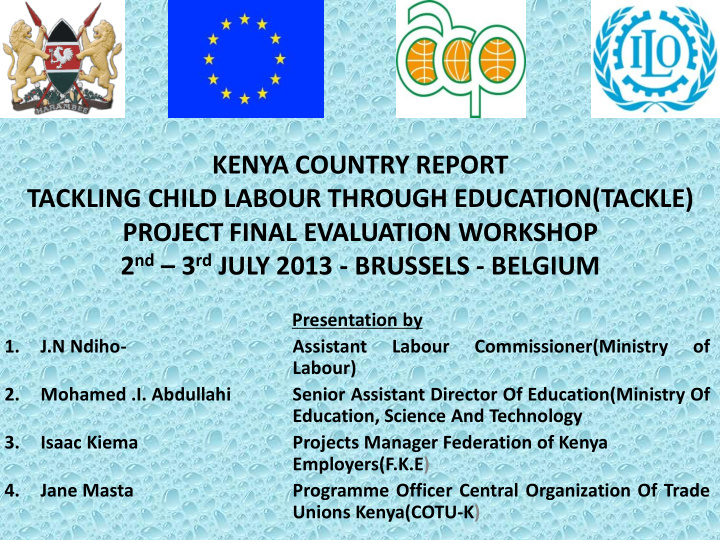



KENYA COUNTRY REPORT TACKLING CHILD LABOUR THROUGH EDUCATION(TACKLE) PROJECT FINAL EVALUATION WORKSHOP 2 nd – 3 rd JULY 2013 - BRUSSELS - BELGIUM Presentation by 1. J.N Ndiho- Assistant Labour Commissioner(Ministry of Labour) 2. Mohamed .I. Abdullahi Senior Assistant Director Of Education(Ministry Of Education, Science And Technology 3. Isaac Kiema Projects Manager Federation of Kenya Employers(F.K.E) 4. Jane Masta Programme Officer Central Organization Of Trade Unions Kenya(COTU-K)
TACKLE CHILD LABOUR ELIMINATION PROJECT IN KENYA Presentation on Result Area 3 : Targeted actions to combat child labour designed and implemented to develop effective demonstration models
National Population Kenya at a Glance • Population 38.6 million (2009 Census) TACKLE direction action implementation sites Education Indicators (2013) • ECD (2,405,504): NER= 53.3%, GER= 66.3% • Primary (9,970,981): NER= 95.3%, GER= 115.8% • Secondary (1,914,823): NER= 33.1%, GER= 49.3% • Expenditure: %GDP = 15.34% • %GDP expenditure in sector = 4%, i.e.(ECD, Pry, Sec only) • Approx 1 M children engaged in CL
Major results of Direct Actions 1. Direct support to children withdrawn and prevented from child labour – 3000 children withdraw/prevented from WFCL – 100 children finalized skills/entrepreneurship – 2700 in primary/secondary school education programs – 343 children in Lchekuti (shepherd), NFE program – Community based monitoring ( Nyumba Kumi – ten households) cluster initiative (creating CL free zone) – Child Rights Clubs in Schools
Skills/entrepreneurship training Programme 1: IGA Model beneficiary at his enterprise Empower communities and schools for poverty reduction through provision of services such as: – Apprenticeship; – Business training; – Formation of women groups for bee keeping (Siaya); – Agriculture activities; – Business start up kits
Programme 2 . Adopt a school strategy : Miwani primary school in Machakos Achievement: Increased enrolment from 11(2010) to 91 ( 2013)pupils who were previously in child labour Increased participation of the Parents, Community , local leaders and other organizations eg. Churches ,CBOs in school management issues
Adopt A School Initiative (Continued) • A corporate Social Responsibility for private sector partnership to combat child labour • AIG insurance Kshs 1.5 million (USD 17,441) investment on school infrastructure improvement – increased enrolment, from 11 learners to 90 learners. Children no longer going to work, community embraced education (we can do it feeling) • Additional companies willing to invest
Programme 3 Model of flexible schools developed among pastoralist communities in Samburu Central District. Achievement Provided access to basic literacy and numeracy to 343 Children( boys 204, girls 139) and youth of Samburu pastoral community 50 pupils transit to formal schools annually from the 5 Lechekuti ( Mobile )schools
Lunch time at Kaptait Pry School Programme 4: School feeding • Sustainable school feeding initiatives, growing of crops on school compound • Irrigation scheme on school farms • Improved school retention • Improved school performance • Community involvement to support the feeding program • TACKLE model enabled the GoK to implement Home Grown school feeding initiative
Programme 5: Data collection Developed digitalized data collection tool to capture on child labour activities which will be fed into the National data base of National Council of Children ’ s Services. Achievement Enhanced capacity for data collection from implementing agencies which will be used for policy formulation and programming.
Other programmes on combating child labour • Technical support to MOL on initiation of round table forum – leading to effective coordination of tackling child labour activities/mobilizing resources • Workers capacity building activities on tackling child labour through education • Economic empowerment of families – tackling poverty at the household level, hence improved protection and education opportunities for vulnerable families
Lessons learned • Need to provide knowledge on disasters and risk deduction and strengthen the traditional methods of coping with droughts and emergencies. • Capacity building for the teacher on service training for best class room practices and school management committees on school management and governance. • Need for Increased resources for effective monitoring and evaluation. • Structured and targeted Continuous sensitization and advocacy on Child Labour.
Way forward • Scaling up the programme geographical coverage. • Mainstreaming CL into existing school data collection tools • Strengthening institutional capacity • Develop M&E tool in line with requirements of National Children’s Database • Accelerate Fight against CL through the Kenya devolved governance structure. • Promote Regional corporation on eliminating CL
THANK YOU.
Recommend
More recommend